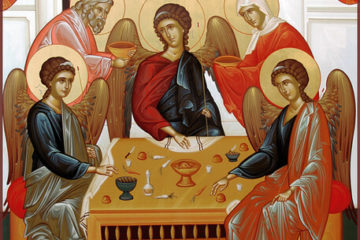For You are praised by the angels, archangels, thrones, dominions, principalities, authorities, powers, and the many eyed Cherubim. Round about You stand the Seraphim, one with six wings and the other with six wings; with two they cover their faces; with two they cover their feet; with two they fly, crying out to one another with unceasing voices and ever resounding praises:
(Priest)Singing the victory hymn, proclaiming, crying out, and saying:
(People)Holy, holy, holy, Lord of Sabaoth, heaven and earth are full of Thy glory. Hosanna in the highest. Blessed is He that comes in the name of the Lord. Hosanna in the highest.
—
In the year that King Uzziah died, I saw the Lord sitting upon a throne, high and lifted up; and His train filled the temple. Above Him stood the Seraphim; each had six wings: with two he covered his face, and with two he covered his feet, and with two he flew. And one called to another and said: “Holy, Holy, Holy is the Lord of hosts; the whole earth is full of His glory.”
Isaiah 6:1-3
One of the most powerful images in the Bible is the vision of Isaiah in the temple of the Lord. We will reflect on Isaiah 6:1-3 in this reflection and Isaiah 6:4-7 in a later reflection. In these three verses, the prophet sees a vision of heaven. He sees the Lord sitting on His throne. The Lord is surrounded the Seraphim, one of nine orders of angels. Each of the Seraphim has six wings, but no body. With two of the wings, they cover their faces, with two they cover their feet and with two they fly. The Seraphim converse with each other, crying out “Holy, Holy, Holy is the Lord of Hosts; the whole earth is full of His glory.”
These three verses are one of a myriad of examples of how the words, phrases and hymns of the Divine Liturgy are taken directly from Scripture. In every line of the Divine Liturgy, there is at least an inference to Scripture. However, in this instance and many others, a prayer or hymn will be a direct quote.
This first prayer of the Anaphora, a prayer the references and describes the Holy Trinity is about to end. It ends by stating how God is surrounded by nine orders of angels—angels, archangels, thrones, dominions, principalities, authorities, powers, the Cherubim and the Seraphim. The angels have been classified in three groups of three, three tiers, with the first hierarchy being closest to God. (https://orthodoxwiki.org/Angels) In the third hierarchy, the ones farthest from God, are the angels (in which are our guardian angels), archangels (like Michael and Gabriel who represent God and who speak to us on behalf of God. In the hierarchy closest to God are the Seraphim and the Cherubim.
In the setting up our Altar sanctuaries, around the Altar table there are always at least two (and some churches have four or six, always an even number), there are circular discs, that in Greek are called “Exapteryga” (literally meaning “six wings”) which are sometimes called “fans”. In some Orthodox jurisdictions these Exapteryga” are held over the gifts after they are placed on the Altar, and most especially after the consecration, and are “fanned” over the gifts, which represents the Holy Spirit hovering over the Gifts, and also represents he presence of those angels around the throne of God.
Saint Basil mentions the nine orders of saints as he concludes the prayer. As many priests offer the inaudible prayers, inaudibly, as opposed to offering them out loud so that the people can hear them, what comes next is the audible line that is familiar to many of us: “Singing the victory hymn, proclaiming, crying out, and saying” which is intoned by the priest.
The people then sing the hymn “Holy, Holy, Holy, Lord of Sabaoth, heaven and earth are full of Thy glory. Hosanna in the highest. Blessed is He that comes in the name of the Lord. Hosanna in the highest.” The hymn combines the hymn of the angels, in Isaiah 6:3, with the chants of the people on Palm Sunday, when Jesus entered into Jerusalem on a donkey. Matthew 21:9, Mark 11:9 and John 12:13 all include this phrase “Hosanna in the highest, blessed is He who comes in the name of the Lord!”
The power and humility of God are each presented in this hymn. While heaven and earth are filled with the glory of God, we are reminded that Christ revealed Himself not as a mighty warrior but as a humble king. Yet the grandeur of God, with the universe filled with His glory and angels standing around His throne paint an image of something that all of us hope to one day see. The path there, for each of us is humility. Again, what an amazing composition by Saint Basil—to outline for us both the goal and the path in imagery that is so profound and yet so simple, a profound destination with a road that is easy to understand, though hard to travel. Now that we have finished the first prayer of the Anaphora, we are ready to dive into the second prayer, a succinct but amazing summary of the history of salvation, from the creation to the second coming.

0 Comments